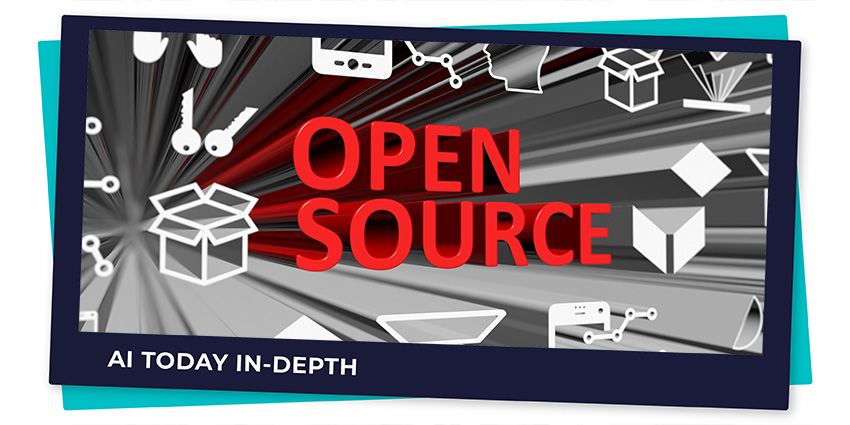Open source AI is quickly emerging as one of the most crucial forms of artificial intelligence in the modern world. Open Source Software (OSS) in the AI landscape ensures anyone can learn, use, share, and enhance intelligent models, for countless different use cases.
It’s a major component in ensuring the artificial intelligence landscape can continue to evolve – not just becoming more powerful and intuitive, but more ethical and secure too. Today, many developers prefer the versatility of open-source AI frameworks over proprietary software and APIs. In fact, in 2023, 80% of respondents in an Open Source report cited a surge in open-source software usage.
But what exactly is open source AI? Why is it so beneficial, and what are the top solutions you can use if you want to experiment with open models yourself?
What is Open Source AI?
On a broad scale, Open Source AI is a type of artificial intelligence created with freely available code, frameworks, and models. It fosters a collaborative environment where developers can modify, use, and distribute new AI technologies, expediting the growth of AI applications.
Open source projects, available through platforms like GitHub, have powered innovation across countless sectors, from education, to finance and healthcare. The availability of AI frameworks across a range of platforms from Linux and Windows, to iOS and Android gives developers exceptional freedom to address a range of challenges with AI.
With access to existing frameworks and libraries, development teams can easily create tailored solutions, reducing the time and resources that go into AI development. Developers have created solutions for real-time fraud prevention, personalized retail recommendations, medical image analysis, and even autonomous machines.
More than simply democratizing access to AI, open source solutions foster a collaborative and transparent environment for AI creation, contributing to more ethical AI practices.
Notably though, open source AI is different from “free AI applications”. With open source solutions, the underlying code is available to the user for modification – that’s not always the case with free tools. Additionally, it’s worth noting that defining open-source AI is becoming increasingly complex.
The Complexity of Defining Open Source AI
Although there are general agreements about what open AI should be, the definition of this technology is complex. As noted by the MIT team, definitions of open source AI frequently vary. That’s because AI has come a long way over the years.
The Open Source Initiative, founded in 1998, originally defined what it meant to be “open source”, but a lot has changed since then. AI is evolving too rapidly for us to wait around for a new document to be published, although the OSI has begun conducting more research into AI opportunities.
Fuzzy insights into what determines “open source” has led to confusion. For instance, Meta’s Llama models are considered “open source”, but they also come with licenses that restrict what users can do with these models – something that’s outlawed by the OSI open-source definition.
Many experts agree that, as AI continue to evolve, we need a more comprehensive, global definition of what AI should include. On a broad scale, this might mean agreeing on standards for:
- Collaborative development: Allowing for co-design processes between groups and developers to enable rapid and multi-perspective iteration in AI models.
- Dataset flexibility: AI is trained on data, and in open source AI, training data may need to be readily available. However opinions on what these datasets should include often vary.
- Open source algorithms: Core statistical models and algorithms should be available within open-source libraries, allowing for flexible iteration and training.
- User interfaces: For open source AI to thrive, the developer interface for using AI tools should be easily accessible, for people with all kinds of coding knowledge.
The Advantages of Open Source AI
We’ve already touched upon some of the benefits of open source AI, such as making various forms of AI available to users from all backgrounds for development purposes. On a broad scale, evolutions in open source AI deliver benefits such as:
- Diverse use cases: As mentioned above, open source AI solutions give developers the freedom to create applications for various practical applications. They empower innovators to create solutions to a range of common real-world problems, without restrictions.
- Accessibility: Open source projects and AI models are openly available to researchers, organizations, and developers, enhancing AI democratization. They help to prevent companies from being locked into partnerships with specific vendors.
- Data protection: Open source AI empowers developers to maintain more control over their data. They can avoid sharing specific pieces of data with larger companies and framework developers, and manage their own data environments.
- Transparency: The collaborative nature of open-source AI can help to foster transparency in artificial intelligence. This is a crucial component of building ethical AI systems that are explainable, and it’s also key to enabling consistent, iterative improvement.
- Affordability: With access to open-source solutions, developers can generally access AI resources and models at a fraction of the cost of creating solutions from scratch. Developers, for instance, can run Llama 3.1 on their own infrastructure at about half of the cost associated with closed models like GPT-4o, according to Meta.
The Challenges of Open Source AI
Just like many forms of artificial intelligence, Open Source AI has almost as many challenges as benefits. First, as mentioned above, definitions about what “open source” solutions should entail can often vary. On top of this, there are issues to consider with:
- Project failures: Open source AI projects are highly experimental. There’s always a risk that developers could end up wasting time and resources on a model that doesn’t perform as expected, or fails to deliver the correct results.
- Data issues: Biased training data is still a problem with open source AI, particularly for developers who have limited access to their own unique data sets. This can lead to biased algorithms that generate flawed results, undermining the reliability of AI solutions.
- Security concerns: The overall accessibility of open source AI solutions raises various security concerns, as malicious actors could easily exploit tools to create harmful applications, such as deepfakes, or hacking applications.
Even some of the biggest AI companies in the world are divided over opinions about open source AI. Some believe that open source is the future, such as Meta, and IBM. Others, like Google and Microsoft, believe a closed approach is the safer option.
Government groups throughout the EU and US believe a balanced approach is essential, which could mean standards surrounding open source AI evolve in the years ahead.
The Top 13 Open Source AI Platforms Available Now
Despite the potential challenges, there’s no denying that open source AI has incredible potential, and value to offer developers. For those keen to experiment with the landscape, there are currently multiple open source AI platforms available to explore. Here are some of the top options.
1. TensorFlow
Tensorflow is one of the top open source AI platforms worldwide, used by companies like Airbus, Airbnb, Coca Cola, and GE Healthcare. Google even uses TensorFlow to power various machine learning applications throughout applications like Gmail and Google Translate.
Compatible with programming languages like JavaScript and Python, Tensorflow empowers programmers to create and implement ML models across a host of devices and platforms. It has a flexible computational graph for diverse environments and a massive community ecosystem.
Tensorflow helps streamline development processes, allowing practitioners to innovate and experiment with AI in a scalable environment. However, it’s primarily focused on numerical data, making it less suitable for symbolic reasoning, and can be complex for beginners.
2. Keras
Another Open Source AI solution based heavily on Python, Keras is popular for its modular design and user-friendly interface. It enables rapid prototyping for deep learning models, and comes with a high-level API, suitable for both advanced users and beginners.
Keras supports the creation of applications for everything from computer vision and image enhancement, to training deep learning models. It runs on top of countless backends too, such as Tensorflow and Pytorch, and supports deployment across all kinds of environments. You can use Keras with servers, browsers, mobile devices and more.
The biggest challenge with Keras is that it focuses very much on deep learning, which may make it less suitable for smaller machine-learning tasks.
3. PyTorch
Another well-known vendor in Open Source AI, Pytorch powers solutions like Amazon Ads, and has even formed the foundation for AI solutions built by NASA and IBM. The intuitive interface of Pytorch makes it easy to debug complex code for deep learning models.
It integrates with Python libraries, and supports GPU acceleration (crucial for model training and experimentation). Many developers and researchers use this platform for rapid software prototyping, particularly related to computer vision and natural language processing.
Python also has a massive community following, and the API structure is relatively easy to use. However, it has suffered from some performance issues in the past, compared to competitors like TensorFlow.
4. Rasa
For innovators in the conversational AI landscape, Rasa is an intuitive open-source platform that allows users to create all kinds of virtual assistants and chatbots. Various companies, such as American Express, Adobe, and Accenture, already use this environment.
Rasa offers access to machine learning technology that allows users to adjust how machines understand and generate natural language responses comprehensively. It comes with access to pre-built elements for designing assistants and chatbots, and a flexible architecture for integration and customization purposes.
The main issue with Rasa is that it’s primarily focused on chatbot and virtual assistant development, so there’s less scope for creating different AI models.
5. OpenAI
There’s some speculation over whether OpenAI can still be classified as an “open source” solution, considering the licensing fees that come with certain types of models. However, OpenAI still provides access to flexible and open frameworks and libraries for AI research and development.
OpenAI has invested in significant cutting-edge research into different techniques for AI development, such as reinforcement learning and the development of large language models. It also provides access to various powerful and customizable tools and GPTs.
However, most of OpenAI’s solutions, aside from options like “Gym” and “Whisper” are now closed source, providing no access to full coding and frameworks.
6. Amazon Sagemaker
Part of an evolving range of artificial intelligence solutions offered by Amazon Web Services (AWS), Amazon Sagemaker is a cloud-based open-source AI system. It helps to simplify the process of training, building, and using machine learning models at scale. Plus, it gives users access to a fully managed platform, full of tools for model training, data labelling, and more.
Amazon Sagemaker features a host of pre-built algorithms for various tasks. It also gives developers a scalable cloud-based infrastructure that is valuable for larger-scale projects. It also integrates with a range of other AWS solutions. However, it does create some vendor lock-in within the AWS ecosystem.
Plus, it’s not “purely” open-source, like some of the other options mentioned here, which means there are less customization options available.
7. Apache MXNet
Apache MXNet is a versatile library for training and developing various language models and AI tools. It supports a number of programming languages, from Python, to Java. It also gives users access to numerous APIs for faster model development. The platform even comes with various capabilities that help users to optimize resource utilization.
Suitable for creating apps linked to NLP, computer vision, and more, MXNET combines imperative and symbolic programming modes for speed and flexibility. It also efficiently scales across various GPUs and machines, enabling support for demanding tasks.
The biggest issue with this platform is its steep learning curve compared to some of the other more “user-friendly” options on this list. It’s also more focused on research and development than some alternatives, which means documentation might be limited.
8. Scikit-Learn
Another Python-based library, Scikit Learn, is an environment that empowers users to create machine learning applications and tools for predictive data analytics. It provides access to scalable unsupervised and supervised machine learning algorithms. It has even helped build the AI frameworks used by companies like Spotify and J.P. Morgan.
This platform’s straightforward setup and user interface, strong community, and collection of versatile, reusable components make it an effective tool for diverse applications. The main downside is that it primarily focuses on classical algorithms, with reduced support for deep learning. It’s also less capable of managing larger data sets than some specialized libraries.
9. OpenCV
Well-known for it’s open source AI platform enabling computer vision application development, OpenCV is a huge library packed with programming functions. It offers real-time performance, extensive platform compatibility, and access to a huge community.
This platform is best suited to organizations that want to automate tasks with computer vision, analyze data, and create video processing tools or solutions for object detection. Its scalability, thanks to its being written in C, makes it very versatile.
The platform is also free to use, even if you’re creating applications for commercial purposes, which isn’t always the case with some platforms claiming to be “open source.”
10. H2O.ai
The group behind H2O.ai is committed to making AI accessible to everyone, helping researchers and developers understand how AI works and deploy their own machine-learning models. The platform comes packed with algorithms and tools for tasks like feature engineering and data pre-processing. Plus, it offers access to enterprise-grade support.
The scalable infrastructure is excellent for building and managing models enhanced with big data. It supports both automatic model tuning and hyperparameter optimization. In addition, it comes with a user-friendly interface and visual workflow options.
Notably, the free version of the platform has limitations on specific resources available to developers, which can be problematic.
11. Acumos AI
A slightly newer entrant to the world of open source AI, Acumos has already been backed by industry leaders like TechMahindra and AT&T. The company was created to ensure tech giants like Apple, Google, and Microsoft couldn’t simply “own” the AI market.
This open-source platform gives users a design studio based on Linux, where they can experiment with AI tools, build and share applications, and even enable integrations with existing software. There’s a huge marketplace full of different libraries and a graphical tool that helps beginners manage their AI models in a more intuitive space.
The GUI design studio feature is definitely one of the most significant benefits of Acumos AI, making visual programming and AI development more accessible.
12. ClearML
ClearML started life as “Allegro AI”, a group providing open source AI tools to machine learning labs and data scientists. When the company rebranded, it introduced a free hosted plan allowing scientists to manage AI/ML experiments and orchestrate workloads without additional investment.
ClearML is a unified platform with access to convenient low-code solutions for building, training, and deploying various generative AI applications. It supports experiment orchestration inside containers, automation, and remote allocation of computing resources with a single line of command.
It also gives companies a handy collaborative environment for teamwork. Plus, there are optional “paid” add-ons, like managed services and priority support.
13. OpenNN
OpenNN is an open-source library of neural networks intended for applications reliant on machine learning and deep learning. The platform primarily supports the development of customer intelligence and predictive analytics software.
The platform features a C++ software library and regression analysis for modeling ML outputs. Users can also take advantage of data classification for specific patterns and association mapping between variables. There’s also a neural designer tool to streamline building neural networks from scratch.
Companies like SEAT, Philips, and even the University of Washington have used this toolkit to build intelligent machine-learning models for various use cases.
The Future of Open Source AI
Despite various complexities to overcome, open-source AI is reshaping enterprise transformation. Its influence spans various industries, driving the widespread adoption of AI technologies and advanced integrations. Advancements in NLP and computer vision libraries, alongside machine learning frameworks will only continue to enhance the potential of open source AI solutions.
However, adopting this technology will still require a careful approach. We will need to redefine globally when it means for AI to be “open source.” going forward. Plus, every user in this landscape must ensure they’re following careful best-practice guidelines to avoid exposure to significant risks.
Without the right strategy, open source AI can still lead to significant issues with security, bias, and even unethical practices.








